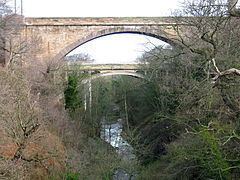OS grid reference NT765721 Post town COCKBURNSPATH Local time Wednesday 2:24 AM | Postcode district TD13 Dialling code 01368 | |
 | ||
Weather 5°C, Wind SW at 18 km/h, 97% Humidity | ||
Dunglass is a hamlet in East Lothian, Scotland, lying east of the Lammermuir Hills on the North Sea coast, within the parish of Oldhamstocks. It has a 15th-century collegiate church, now in the care of Historic Scotland. Dunglass is the birthplace of Sir James Hall, an 18th-century Scottish geologist and geophysicist. The name Dunglass comes from the Brittonic for "grey-green hill".
Contents
Map of Dunglass, Cockburnspath, UK
Geography
Dunglass is a small settlement located about 1 km (0.5 mi) northwest of Cockburnspath and 11 km (7 mi) southeast of Dunbar. The whole of Dunglass lies in an area of 2.47 km². It lies to the east of the Lammermuir Hills on the North Sea coast at the point where the old Great North Road and modern A1 as well as the London-Edinburgh railway cross the gorge of the Dunglass Burn. The burn forms the boundary between the shires of East Lothian and Berwick. Other settlements nearby include Cove, Pease Bay, and Pease Dean.
Dunglass Castle and estate
Dunglass Castle was built by the Pepdies of Dunglass in the 14th century. On the marriage of Nicola Pepdie to Sir Thomas Home, the castle and lands passed to the Home family. It remained in their possession until their forfeiture in 1516, when it passed to Archibald Douglas, Earl of Angus, but it was later besieged and destroyed by the English under the command of Earl Henry of Northumberland in the winter of 1532, and again under Duke Edward of Somerset in 1547, when held by Sir George Douglas.
The castle was rebuilt, in an enlarged and improved form, and gave accommodation in 1603 to King James VI, and all his retinue, when on his journey to London to take up the English throne.
However, it was again destroyed on 30 August 1640 when held by a party of Covenanters under Thomas, Earl of Haddington. An English page, according to Scotstarvet, vexed by a taunt against his countrymen, thrust a red-hot iron into a powder barrel, and himself was killed, with the Earl, his half-brother, Richard, and many others.
The Hall family occupied Dunglass for 232 years from 1687. Francis James Usher bought the Estate from Sir John Richard Hall, 9th Bart in 1919, and the estate remains in the Usher family. The Earl of Home continues to hold the title "Lord of Dunglass", despite the fact his family have not held Dunglass for several centuries.
Sir James Hall
In the Spring of 1788, the geologist Sir James Hall together with John Playfair and James Hutton set off from Dunglass Burn in a boat heading east along the coast looking for evidence to support Hutton's theory that rock formations were laid down in an unending cycle over immense periods of time. They found examples of Hutton's Unconformity at several places, particularly an outcrop at Siccar Point sketched by Sir James Hall. As Playfair later recalled, "The mind seemed to grow giddy by looking so far back into the abyss of time".
